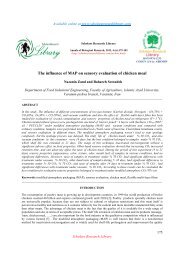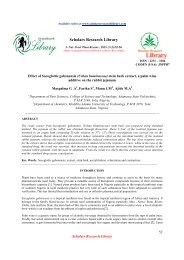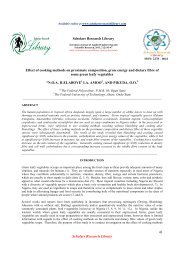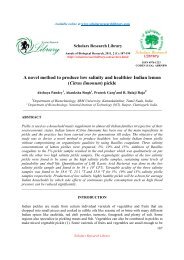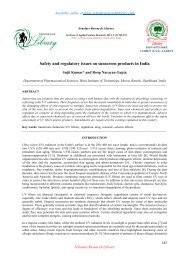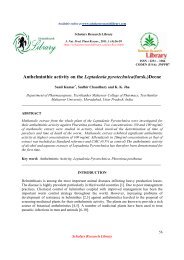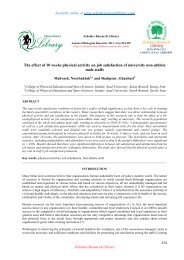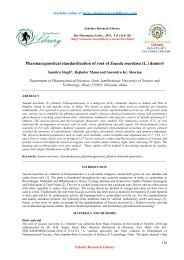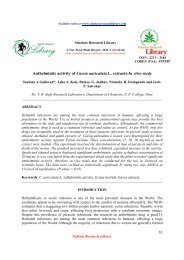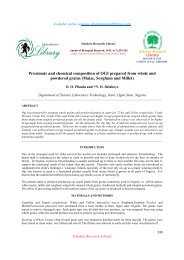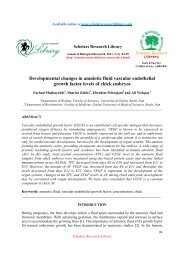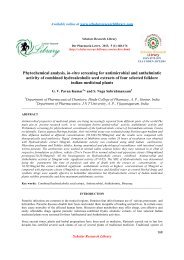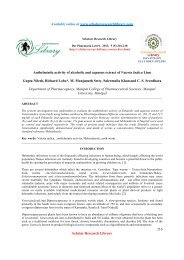Spectrophotometric, chromatographic and spectrofluorometric ...
Spectrophotometric, chromatographic and spectrofluorometric ...
Spectrophotometric, chromatographic and spectrofluorometric ...
Create successful ePaper yourself
Turn your PDF publications into a flip-book with our unique Google optimized e-Paper software.
Available online at www.scholarsresearchlibrary.com<br />
Scholars Research Library<br />
Der Pharmacia Lettre, 2011, 3 (6):257-265<br />
(http://scholarsresearchlibrary.com/archive.html)<br />
ISSN 0975-5071<br />
USA CODEN: DPLEB4<br />
<strong>Spectrophotometric</strong>, <strong>chromatographic</strong> <strong>and</strong> <strong>spectrofluorometric</strong><br />
methods for the determination of diclofenac: A review<br />
G. P<strong>and</strong>ey<br />
Department of Pharmacy, Barkatullah University Bhopal (M.P.) India<br />
______________________________________________________________________________<br />
ABSTRACT<br />
Diclofenac is a Non-steroidal anti-inflammatory drugs (NSAIDs) are the group most widely used<br />
in human <strong>and</strong> veterinary medicine, since it is available without prescription for treatment of<br />
fever <strong>and</strong> minor pain. The clinical <strong>and</strong> pharmaceutical analysis of these drugs requires effective<br />
analytical procedures for quality control <strong>and</strong> pharmacodynamics <strong>and</strong> pharmacokinetic studies.<br />
An extensive survey of the literature published in various analytical <strong>and</strong> pharmaceutical<br />
chemistry related journals has been conducted <strong>and</strong> the instrumental analytical methods which<br />
were developed <strong>and</strong> used for determination of diclofenac (an aryl acetic acid derivative) in bulk<br />
drugs, formulations <strong>and</strong> biological fluids have been reviewed. This review covers the time period<br />
from 1989 to 2010 during which 43 methods including spectroscopic, <strong>chromatographic</strong><br />
titrimetric methods were reported. The application of these methods for the determination of<br />
diclofenac in pharmaceutical formulations <strong>and</strong> biological samples has also been discussed.<br />
______________________________________________________________________________<br />
INTRODUCTION<br />
Non-steroidal anti-inflammatory drugs (NSAIDs) are a group of drugs of diverse chemical<br />
composition <strong>and</strong> different therapeutic potentials having a minimum of three common features:<br />
identical basic pharmacological properties, similar basic mechanism of action as well as similar<br />
adverse effects. Moreover, all drugs in this group exhibit acidic character. Most NSAIDs are<br />
weak acids, with a pKavalues in the range of 3.0–5.0 (acids of medium strength)[1].<br />
Diclofenac is easily available <strong>and</strong> effective <strong>and</strong> thus are extensively used by patients. The<br />
growing dem<strong>and</strong> for this agents calls for higher level of quality control of these its preparations,<br />
so that they are in the highest possible degree free from any impurities that may come from the<br />
production process, as well as from decomposition products of active or auxiliary substances.<br />
Therefore, it seems appropriate to develop new analytical methods regarding their qualitative <strong>and</strong><br />
quantitative analysis[2].<br />
Introduction of new methods, enabling carrying out determinations with maximum accuracy,<br />
contributes to increased interest in analytical methods as such. They should enable to<br />
Scholar Research Library<br />
257
G. P<strong>and</strong>ey Der Pharmacia Lettre, 2011, 3 (6):257-265<br />
_____________________________________________________________________________<br />
simultaneously determine the individual components in multicomponent preparations <strong>and</strong> in<br />
biological material.Development <strong>and</strong> validation of analytical methods are of basic importance to<br />
optimize the analysis of drugs in the pharmaceutical industry <strong>and</strong> to guarantee quality of the<br />
commercialized product[3]. The present review comprises references covering the period from<br />
1989 to 2011 that have been used for the determination of diclofenac in individual dosage form<br />
or in the combination with other drugs.<br />
Various analytical methods developed for diclofenac<br />
An accurate <strong>and</strong> precise spectrophotometric method was described for the determination<br />
of diclofenac sodium in bulk samples <strong>and</strong> pharmaceutical preparations. With p-N, N-<br />
dimethylphenylenediamine as solvent <strong>and</strong> maximum absorbance at 670nm. The reaction is<br />
sensitive enough to permit the determination of 2.0–24µg/ml[4].<br />
A spectrophotometric method was described for the determination of diclofenac sodium in<br />
bulk samples <strong>and</strong> pharmaceutical preparations. The method is based on the reaction of diclofenac<br />
sodium with pN,N-dimethylphenylenediamine in the presence of Sor Cr(VI) whereby an<br />
intensely coloured product having maximum absorbance at 670 nm is developed. The reaction is<br />
sensitive enough to permit the determination of 2.0–24 µg /ml [5].<br />
The determination ofdiclofenac was done by two methods. In the first<br />
method diclofenac reduces iron(III) to iron(II) having a maximum absorbance at 520nm. The<br />
reaction obeys Beer’s law for concentrations of 10–80µg/ml. In the second method, diclofenac is<br />
treated with methylene blue in the presence of phosphate buffer (pH6.8) <strong>and</strong> the complex is<br />
extracted with chloroform. The complex has a maximum absorbance at 640nm <strong>and</strong> linearity was<br />
in the range 5–40µg/ml[6].<br />
Diclofenac sodium, famotidine <strong>and</strong>ketorolac tromethamine were determined by FIA with<br />
spectrophotometric detection. The sample solution 5.0–50 µg/ml of diclofenac sodium, in<br />
methanol was injected into a flow system containing 0.01% (w/v) of 2,4,dichloro-6-nitrophenol<br />
(DCNP) in methanol. The colour produced due to the formation of a charge transfer complex<br />
was measured with a spectrophotometric detector set at 450 nm. A sampling rate of 40 per hour<br />
was achieved with high reproducibility of measurements RSD 6 1.6% [7].<br />
A procedure for simultaneousestimation of diclofenac sodium, chlorzoxazone<br />
<strong>and</strong>paracetamol in three component tablet formulations has beendeveloped. The method is based<br />
on the native ultravioletabsorbance maxima of the three drugs in 0.02 mol/ Lsodiumhydroxide.<br />
Diclofenac sodium has absorbance maxima at276 nm[8].<br />
A validated method has been developed for estimation of diclofenac in bulk <strong>and</strong> formulation.<br />
With 0.5%w/v sodium hydroxide as solvent <strong>and</strong> maximum absorbance at 450nm. Method obeys<br />
Beer’s law in the concentration range of 2.0–12µg/ml [9].<br />
The methods employ first derivative ultraviolet spectrophotometry, simultaneous equations<br />
<strong>and</strong> the program in the multicomponent mode of analysis of the instrument used, for the<br />
simultaneous estimation of the two drugs. In 0.02 mol / L sodium hydroxide, diclofenac sodium<br />
has maxima at 276 nm [10].<br />
Scholar Research Library<br />
258
G. P<strong>and</strong>ey Der Pharmacia Lettre, 2011, 3 (6):257-265<br />
_____________________________________________________________________________<br />
A new accurate, precise <strong>and</strong> reproducible method has been devised for the determination<br />
of diclofenac sodium in bulk <strong>and</strong> in pharmaceutical preparations using Eu(III) ions as the<br />
fluorescent probe. In aqueous solution the measurement was performed at 616nm <strong>and</strong> 592nm. A<br />
linear relationship between bound Eu(III) <strong>and</strong> the concentration of diclofenac sodium was found<br />
from 10- 200µg/ml[11].<br />
A new accurate <strong>and</strong> precise spectrophotometric method in which diclofenac sodium is<br />
analyzed <strong>and</strong> determined as it is Fe(III) complex, with chloroform as solvent <strong>and</strong> maximum<br />
absorbance at 481nm. Beer’s law was found up to 1.57–15.7 Mmol/L [12].<br />
A colorimetric method was developed for the quantitative determination<br />
of diclofenac sodium in pure form <strong>and</strong> in pharmaceutical preparations. It was based on the<br />
interaction of the secondary aromatic amine with p-dimethylaminocinnamaldehyde in acidified<br />
absolute methanol medium to form very stable red products [λ max at 538 nm]. Beer’s law was<br />
obeyed over the range of 10–80µg/ml[13].<br />
The <strong>spectrofluorometric</strong> determination of diclofenac sodium in pharmaceutical tablets <strong>and</strong><br />
ointments was described. It involves excitation at 287 nm of an acid solution (HCl 0.01 M) of the<br />
drug <strong>and</strong> measurement of the fluorescence intensity at 362 nm. The linear range is 0.2–<br />
5.0 µg/ml[14].<br />
Two economic <strong>and</strong> reproducible methods for the determination of the diclofenac salts<br />
[sodium or diethylammonium] in three pharmaceutical formulations (tablets, suppositories <strong>and</strong><br />
gel) were presented. In the first, diclofenac salt is determined both by measuring the absorbance<br />
of the solutions at a fixed wavelength (λ =276nm) <strong>and</strong> using a multiwavelength computational<br />
program to process the spectrophotometric data in a selected range (λ 230–340 nm). In this case,<br />
the analysis is performed measuring the peak-to-peak amplitude in the first-derivative UV<br />
spectrum ( 1 D 261- 296). In the second method, diclofenac is precipitated in acid medium <strong>and</strong><br />
determined by the analysis of the endothermic peak (t p = 182°C) in the DSC curve obtained in<br />
nitrogen atmosphere[15].<br />
A accurate, economic <strong>and</strong> reproducible second derivative spectrophotometric method has<br />
been developed for the determination of the degradation products of diclofenac sodium from gelointment.<br />
The amplitudes in the second derivative spectra at 260 <strong>and</strong> 265 nm were selected to<br />
determine diclofenac sodium in 0.1M NaOH solution[16].<br />
A rapid, accurate <strong>and</strong> reproducible spectrophotometric method for the determination<br />
ofdiclofenac sodium was developed. In 3.0 × 10 −2 mol/L H 2 SO 4 medium. Using the peak height<br />
as a quantitative parameterdiclofenac was determined at 580 nm over the range 0.2–<br />
8.0µg/ml[17].<br />
A rapid, accurate <strong>and</strong> reproducible flourimetric <strong>and</strong> spectrophotometric methods was<br />
proposed for the determination of diclofenac in bulk samples <strong>and</strong> pharmaceuticals with sodium<br />
hydroxides solvent <strong>and</strong> measured at 455nm. The calibration graphs are linear over 0.20–<br />
20 µg/ml[18].<br />
A accurate <strong>and</strong> reproducible method was developed for the determination of diclofenac in<br />
human serum by HPTLC. St<strong>and</strong>ard diclofenac sodium was spotted on silica gel 60<br />
F 254 precoated plates, which were developed using the mobile phase toluene: acetone: glacial<br />
acetic acid (80:30:1v/v/v). Densitometric analysis of diclofenac sodium was carried out at 280nm<br />
Scholar Research Library<br />
259
G. P<strong>and</strong>ey Der Pharmacia Lettre, 2011, 3 (6):257-265<br />
_____________________________________________________________________________<br />
with diclofenac being detected at an R f of 0.58. The extraction efficiency was found to range<br />
from 76 to 80%. The calibration curve of diclofenac sodium in serum was found to be linear in<br />
the range of 200–800ng[19].<br />
A sensitive, accurate <strong>and</strong> reproducible method was developed for the determination of<br />
synthetic precursors which could be remained as impurities in raw drug materials. HPLC was<br />
used to detect <strong>and</strong> separate diclofenac from its usual precursors. The <strong>chromatographic</strong> conditions<br />
were as follows: column, C 18 , mobile phase, methanol: water (55:45), flow rate 1ml/min,<br />
wavelength of detection 254nm[20].<br />
Two modified methods were developed for assaying sodium diclofenac by GLC <strong>and</strong> HPLC.<br />
GLC was equipped with flame ionization detector. SE-30/chrom W-HP (80-100 mesh) was used<br />
as a column in GC. For reversed phase HPLC, the mobile phase was methanol: water (55:45).<br />
The separation was performed on an analytical 300×3.9 mm internal diameter µ-bond pack<br />
phenyl column using UV detection at 274 nm with flow rate of 1.0ml/min. O-(4-chlorobenzoyl)<br />
benzoic acid <strong>and</strong> mefenamic acid were used as internal st<strong>and</strong>ard for GLC <strong>and</strong> HPLC method<br />
respectively[21].<br />
A economic <strong>and</strong> reproducible spectrophotometric method was developed for the<br />
determination of diclofenac sodium in pure form <strong>and</strong> in pharmaceutical formulations was<br />
developed. Measured at 510 nm against a reagent blank of ortho- phenanthroline pH 4.4. Beer’s<br />
law is valid within a concentration range of 1.0–32 µg/ml[22].<br />
An effective method was developed for the determination of sodium or<br />
potassium diclofenac is proposed in its pure form <strong>and</strong> in their pharmaceutical preparations. The<br />
method is based on the reaction between diclofenac <strong>and</strong> tetrachloro-p-benzoquinone (pchloranil),<br />
in methanol medium. This reaction was accelerated by irradiating of reactional<br />
mixture with microwave energy (1100 W) during 27 s, producing a charge transfer complex with<br />
a maximum absorption at 535nm with methanol: water 60:40v/v. Beer’s law is obeyed in a<br />
concentration range from of 1.25 × 10 −4 to 2.00 ×10 −3 mol /L [23].<br />
A economic, accurate <strong>and</strong> reproducible spectrophotometric method was proposed for<br />
determination of sodium diclofenac in pharmaceutical preparations based on its reaction with<br />
concentrated nitric acid (63%w/v). The reaction product is a yellowish compound with<br />
maximum absorbance at 380 nm. The corresponding calibration curve is linear over the range of<br />
1.0–30 µg/ml [24].<br />
A modified procedure was developed for the visible spectrophotometric determination<br />
of diclofenac in pharmaceutical preparations using aqueous solution of copper (II) as reagent.<br />
Concentration was measured at 680 nm. The beer’s law was obeyed between 1mg/ml to<br />
25mg/ml [25].<br />
A method was developed for the evaluation of diclofenac sodium in tablet, injectable <strong>and</strong> gel<br />
type formulations. The diclofenac sodium was analyzed by reverse phase column (SGX C 18<br />
(150mm × 3mm internal diameter 7µm)) using mobile phase methanol <strong>and</strong> phosphate buffer (pH<br />
3.2) <strong>and</strong> detection was done at 282 nm[26].<br />
A colorimetric assay method for diclofenac sodium tablets was developed. The method was<br />
based on a simple aromatic ring derivatization technique using newly developed 4-carboxyl-2, 6-<br />
dinitrobenzenediazonium ion (CDNBD) as chromogenic derivatizing reagent with subsequent<br />
Scholar Research Library<br />
260
G. P<strong>and</strong>ey Der Pharmacia Lettre, 2011, 3 (6):257-265<br />
_____________________________________________________________________________<br />
formation of an azo dye. The diazo coupling reaction was carried out between CDNBD <strong>and</strong><br />
diclofenac. The UV absorption spectrum was recorded <strong>and</strong> absorption λmax at 470nm by using<br />
glacial acetic acid as solvent. The assays were linear over 1.35 -10.8µg/ml of diclofenac[27].<br />
A rapid, economic <strong>and</strong> accurate <strong>spectrofluorometric</strong> method was developed for diclofenac<br />
sodium. Method for the micro determination was based on its reaction with cerium(IV) in an<br />
acidic solution <strong>and</strong> measurement of the fluorescence of the Ce(III) ions produced. The aborbance<br />
was measured at 356nm <strong>and</strong> 250nm with double distilled water as solvent. The range of<br />
application is 124.3–600 ng/ml <strong>and</strong> the limit of detection is 72.7ng/ml[28].<br />
A sensitive, stable <strong>and</strong> reproducible high performance thin layer <strong>chromatographic</strong> method<br />
was developed for the determination of diclofenac sodium in pharmaceutical formulations. The<br />
drug was extracted from the sample then various aliquots of this solution were spotted<br />
automatically by means of Camag Linomat IV on a silica gel 60 F 254 aluminium plate, using a<br />
mixture of toluene : ethyl acetate : glacial acetic acid (60:40:1, v/v/v) as mobile phase. The spot<br />
areas were quantified by densitometry at 282 nm. Linear calibration curve was obtained over the<br />
range 5-80 µg/ml (r 2 = 0.9993)[29].<br />
A reversed-phase high-performance liquid <strong>chromatographic</strong> method with electrochemical<br />
detection was developed for the quantitative determination of diclofenac potassium in plasma.<br />
Naproxen was used as the internal st<strong>and</strong>ard. Chromatographic separation was performed on a C 18<br />
column with methanol: water (68:32 v/v). The flow rate for diclofenac was 1.0 ml/min with<br />
detection wavelength of 275 nm. Linearity of the method was confirmed in the range 5-<br />
2000ng/ml[30].<br />
A rapid, reproducible <strong>and</strong> precise method was developed for determination of diclofenac<br />
released from suppositories using UV spectrophotometry <strong>and</strong> HPLC. The solvent used were<br />
methanol <strong>and</strong> phosphate buffer pH7.3 for UV <strong>and</strong> HPLC. 275nm was used wavelength of<br />
detection for both the methods with a flow rate of 1.5 min/min in HPLC detection [31].<br />
A rapid, accurate <strong>and</strong> reproducible HPLC method to quantitate plasma levels of diclofenac<br />
sodium in human plasma was developed. The internal st<strong>and</strong>ard was naproxen analyzed on µ-<br />
bond pack C 18 (150×4.6mm) in acetonitrile: deionized water: orthophosphoric acid 45:54.5:0.5<br />
(pH3.5) at 276nm <strong>and</strong> linearity of 0.005-4µg/ml [32].<br />
Developed a simple accurate <strong>and</strong> precise reverse phase HPLC method for simultaneous<br />
estimation of diclofenac <strong>and</strong> rabeprazole. The method was developed using HQSiC 18 column<br />
250×4.6mm internal diameter consisting solvent methanol: water in 80:20 v/v ratio at a flow rate<br />
of 1.25ml/min <strong>and</strong> detection at 284.0 nm[33].<br />
A kinetic method was developed for the determination of micro quantities of diclofenac<br />
sodium. The method was based on a lig<strong>and</strong>-exchange reaction. The reaction was followed<br />
spectrophotometrically by monitoring the rate of appearance of the cobalt diclofenac complex at<br />
376 nm in acetic acid as solvent[34].<br />
A rapid, economic, accurate <strong>and</strong> reproducible new spectrophotometric method has been<br />
developed for the determination of diclofenac sodium in pharmaceutical preparations. This<br />
method is based on the reaction of diclofenac sodium with reagent <strong>and</strong> detection of the produced<br />
coloured complex. This ion associate complex was detected <strong>and</strong> extracted with toluene <strong>and</strong> an<br />
Scholar Research Library<br />
261
G. P<strong>and</strong>ey Der Pharmacia Lettre, 2011, 3 (6):257-265<br />
_____________________________________________________________________________<br />
absorption maximum at 566.2 nm against a blank reagent. The calibration graph was linear from<br />
0.9 to 11 µg/ml of diclofenac[35].<br />
An extractive-spectrophotometric method for the preconcentration <strong>and</strong> determination<br />
of diclofenac was developed. In a strong nitric acid medium, diclofenac produced a yellowish<br />
compound in a water/tetrahydrofuran/perfluorooctanoic acid homogeneous phase that could be<br />
extracted into a sediment micro droplet. The concentration of the extracted coloured compound<br />
in the micro droplet was determined by measuring its absorbance at 376 nm. The absorbance<br />
of diclofenac solutions in water: methanol 50:50v/v obeyed Beer’s law, over the range of 1.0–30<br />
<strong>and</strong> 0.5–40 µg/ml[36].<br />
A flow-through sensor for the determination of diclofenac sodium was developed, based on<br />
retention of the analyte on a Sephadex QAE A-25 anion-exchange resin packed in a flow-cell of<br />
1.0mm of optical path length, <strong>and</strong> monitoring of its intrinsic absorbance by UVspectrophotometry<br />
at 281nm in 0.1M NaOH as solvent[37].<br />
A simple, accurate, precise <strong>and</strong> reproducible method for simultaneous estimation of<br />
rabeprazole <strong>and</strong> diclofenac was done by simultaneous equation method <strong>and</strong> graphical absorbance<br />
method using methanol: 0.1M NaOH (70/30v/v). The λmax of rabeprazole <strong>and</strong> diclofenac found<br />
to be 294.0nm <strong>and</strong> 281.2nm[38].<br />
A accurate, sensitive <strong>and</strong> reproducible HPLC assay was developed for diclofenac<br />
measurement in human plasma. Naproxen as internal st<strong>and</strong>ard <strong>and</strong> diclofenac eluted at 3.9 <strong>and</strong><br />
8.3 minutes, respectively, on a Nova-Pak C 18 4µm cartridge, <strong>and</strong> were detected using a 996<br />
photodiode array detector set at 276nm. The mobile phase, 0.2% glacial acetic acid (pH 3.0):<br />
acetonitrile (51:49, v/v), was delivered at 2.0ml/min. Calibration curves were linear in the range<br />
0.02–1.92 µg/ml[39].<br />
A simple, accurate <strong>and</strong> reproducible method for simultaneous <strong>chromatographic</strong> estimation of<br />
diclofenac <strong>and</strong> rabeprazole was developed in tablet formulation by using phenomenex luna (C 18 )<br />
column with the help of mobile phase containing potassium dihydrogen phosphate buffer (pH 7.4<br />
adjusted with 1M sodium hydroxide) <strong>and</strong> acetonitrile in 60:40 ratio by keeping the flow rate of<br />
1.0 ml/min <strong>and</strong> detection wavelength 280.0 nm. Linearity was found between concentration<br />
ranges of 10-50 µm/ ml for both of drugs [40].<br />
A rapid, accurate, precise <strong>and</strong> reproducible UV spectrophotometric method was developed<br />
for determination of diclofenac sodium in human stratum conium by skin stripping method using<br />
marketed diclofenac sodium topical formulations. Diclofenac exhibited distinct λmax in<br />
methanol at 285nm with linear relationship (r 2 =0.9787) in between 5-25µg/ml [41].<br />
A accurate, rapid <strong>and</strong> precise flow extraction spectrophotometric method was developed for<br />
determination of trace amounts of diclofenac sodium. Detection performed at 282 nm against<br />
phosphate buffer pH 6.4 as blank. The method was linear in the range of 3.0–80 µg/ml [42].<br />
Six simple, accurate, precise <strong>and</strong> reproducible methods for simultaneous estimation of<br />
rabeprazole <strong>and</strong> diclofenac were performed in capsule dosage form. The concentration of<br />
individual compound was determined by simultaneous equation method, absorbance ratio<br />
method, dual wave length method, area under curve method, first order derivative<br />
spectrophotometry method <strong>and</strong> multicomponent method. The λmax of rabeprazole sodium <strong>and</strong><br />
diclofenac sodium was found to be 292nm <strong>and</strong> 276nm in 0.01N NaOH solution. Rabeprazole <strong>and</strong><br />
Scholar Research Library<br />
262
G. P<strong>and</strong>ey Der Pharmacia Lettre, 2011, 3 (6):257-265<br />
_____________________________________________________________________________<br />
diclofenac obeys the Beer’s law in concentration range of 5-30 µg/ml <strong>and</strong> 5-35 µg/ml<br />
respectively [43].<br />
<br />
A simple, sensitive, accurate <strong>and</strong> precise RP-HPLC method was developed for the<br />
simultaneous estimation of rabeprazole sodium <strong>and</strong> diclofenac sodium in tablet dosage form. The<br />
method was developed by using a HiQ SiL C18 (250 mm×4.6mm internal diameter) column<br />
with a mobile phase consisting of water: methanol: acetonitrile (20:40:40 v/v), at a flow rate of<br />
1.2 ml/ min <strong>and</strong> detection was carried out at 284 nm[44].<br />
A stable, simple, rapid <strong>and</strong> precise RP-HPLC method for simultaneous analysis of diclofenac<br />
sodium <strong>and</strong> rabeprazole sodium was developed. Separation was carried out using C 8 column with<br />
triethyl amine buffer (pH 5): acetonitrile (50:50 v/v) as mobile phase with flow rate 2ml/min.<br />
The detection was carried out at 284nm [45].<br />
A stability indicating reverse phase high performance liquid chromatography for the<br />
simultaneous determination of rabeprazole <strong>and</strong> diclofenac was developed in solid dosage form.<br />
The method was based on HPLC separation of both drugs in reverse phase mode using<br />
Phenomenox C 18 column with Waters HPLC system by using mobile phase composition of<br />
acetonitrile <strong>and</strong> 50mM ammonium acetate buffer (pH 3.6) (60:40 v/v) at flow rate 1ml/min.<br />
Detection wavelength used at 254 nm. Loratidine was used as internal st<strong>and</strong>ard. Linearity was<br />
obtained in the concentration range of 1.0-3.2 µg/ml for rabeprazole <strong>and</strong> 6.0-16.0 µg/ml<br />
diclofenac [46].<br />
A simple, rapid, economic <strong>and</strong> precise UV spectroscopic method for simultaneous analysis of<br />
diclofenac sodium <strong>and</strong> rabeprazole sodium was developed. Analysis was carried out using water:<br />
methanol (80:20 v/v) as mobile phase. The detection was carried out at 284nm for rabeprazole<br />
<strong>and</strong> at 277.5nm for diclofenac sodium, respective absorption maximum of each other [47].<br />
Applications<br />
The above mentioned methods have applications in the determination of the diclofenac in<br />
various pharmaceutical formulationslike tablets, injections, capsules. These methods give results<br />
which are comparablewith the official pharmacopoeial methods used for thedetermination of<br />
diclofenac;hence, these methods can be successfully used for routine analysis<strong>and</strong> quality control<br />
of diclofenac. The methods have been used for the quantitative determination of the drug in pure<br />
form <strong>and</strong> commercial preparations. The commonly occurring excipients do not interfere in the<br />
determination of the drug in the case of commercial samples. The methods have been validated<br />
<strong>and</strong> results have been found to be accurate, precise <strong>and</strong> comparable to the official methods.<br />
CONCLUSION<br />
This review presents spectrophotometric, <strong>chromatographic</strong> <strong>and</strong> <strong>spectrofluorometric</strong>as well as<br />
fluorometricanalytical methods applied for the determination of confirmation of diclofenac.<br />
Despite wide availability of the equipment, their use is however still limited, especially with a<br />
complicated matrix. The ultimate goal is to obtain results with more <strong>and</strong> more precision <strong>and</strong><br />
accuracy <strong>and</strong> at increasingly lower concentration levels of the substances being determined.<br />
Comparing validation parameters of already researched methods, it can be concluded which one<br />
of them is more sensitive (low LOD <strong>and</strong> LOQ values), accurate (precision <strong>and</strong> recovery) <strong>and</strong><br />
allows markings in a broad linearity scope.<br />
Scholar Research Library<br />
263
G. P<strong>and</strong>ey Der Pharmacia Lettre, 2011, 3 (6):257-265<br />
_____________________________________________________________________________<br />
REFERENCES<br />
[1] M. Starek, J. Krzek, Talanta,2009, 77, 925.<br />
[2] J. Sherma, Planar chromatography. Anal. Chem.,2000, 72, 9R.<br />
[3] A. A. Gouda, M. I. K. El-Sayed, Arabian Journal of Chemistry, 2011,<br />
doi:10.1016/j.arabjc.2010.12.006<br />
[4] C. P. Sastry, T. Prasad, M. V. Suryamarayana, Analyst,1989, 114, 513.<br />
[5] C. P. Sastry, M. V. Suryanarayana,Microchem. Journ.,1989, 39, 277-282.<br />
[6] Y. K. Agrawal, K. Shivramch<strong>and</strong>ra, Journ. Pharm. Biomed. Anal.,1991, 9, 97-100.<br />
[7] B. V. Kamath, K. Shivram, A. C. Shah, J. Pharm. Biomed. Anal.1994, 12, 343.<br />
[8] M. S. Bhatia, S. R. Dhaneshwar, Indian Drugs,1995, 32, 446.<br />
[9] R. Validya, R. S. Parab,Indian Drugs, 1995, 32, 194-196.<br />
[10] “Indian Pharmacopoeia”, Govt. of India Ministry of health <strong>and</strong> family welfare,<br />
Controller of publication, New Delhi, 2007, VolumeII,p. 402.<br />
[11] R. T. Perez, L. C. Martınez, A. Sanz, M. T. S. Miguel,Journ. Pharm. Biomed. Anal., 1997,<br />
16, 249-254.<br />
[12] K. C. Agatonovic, L. Zivanovic, M. Zecevic, D. Radulovic,Journ. Pharm. Biomed. Anal.,<br />
1997, 16, 147-153.<br />
[13] Z. A. El Sherif, M. I. Walash, M. F. El-Tarras, A. O. Osman,Anal. Lett.,1997, 30, 1881-<br />
1896.<br />
[14] M. S. Garcia, M. I. Albero, P. C. Sanchez, J. Molina,Journ. Pharm. Biomed. Anal.,1998, 17,<br />
267-273.<br />
[15] R. Bucci, A. D. Magri, A. L. Magri,Fresenius J. Anal. Chem.,1998, 362,577-582.<br />
[16] I. Karamancheva, I. Dobrev, L. Brakalov, A. Andreeva,Anal. Lett.,1998, 31, 117-129.<br />
[17] B. P. Ortega, M. A. Ruiz, M. L. Fern<strong>and</strong>ez-de Cordova, D. A. Molina,Anal. Sci.,1999, 15,<br />
985-989.<br />
[18] S. Garcia, P. C. Sanchez, I. Albero, C. Garcia,Microchim. Acta.,2001, 3, 67-71.<br />
[19] L. G. Lala, P. M. Mello, S. R. Naik, Journ. Pharm. Biomed. Anal.,2002, 29, 539-544.<br />
[20] M. H. H. Tehrani, F. Farnoush. E. Maryam, Iranian J. Pharm. Res., 2002, 1,51-53.<br />
[21] A. Shafiee, M. Amini, M. Hajmahmodi,Journ. Sci. Islam. Repub. Ira., 2003, 14, 21-25.<br />
[22] A. M. El- Didamony, A. S. Amin,Anal. Lett.,2004, 37,1151-1162.<br />
[23] E. G. Ciapina, A. O. Santini, P. L. Weinert, M. A. Gotardo, H. R. Pezza, L. Pezza,Eclet.<br />
Quim.,2005, 30, 29-36.<br />
[24] A. A. Matin, M. A. Farajzadeh, A. Jouyban,Farmaco.,2005, 60, 855-858.<br />
[25] R. L. DeSouza, M. Tubino, Journ. Braz. Chem. Soc.,2005, 16,1068-1073.<br />
[26] L. Hanysova, R. Mokry, P. Kastner, J. Klimes, Chem. Pap.,2005, 59, 103-108.<br />
[27] S. I. Olakunle, A. A. Olajire, A. O. Bolaji, A. O. Ajibola, Pak. J. Pharm. Sci., 2006, 19,<br />
134-141.<br />
[28] A. C. Marcela, B. Liliana,Analy. Sci.,2006, 22,431-434.<br />
[29] W. Thongchai, B. Liawruangrath, C. Thongpoon, T. Machan, Chi. Mai. Journ. Sci.,2006,<br />
33, 123-128.<br />
[30] A. Chmieleska, A. Plenis, M. Bieniecki, H. Lamparczyk,Biomed. Chromatogr.,2006,<br />
20,119-124.<br />
[31] M. Sznitowska, G. M. Stokrocka, Acta. Poloni. Pharma. Drug Res., 2007, 63,401-405.<br />
[32] J. Emami, N. Ghassami, R. Talari, DARU, 2007, 15, 132-138.<br />
[33] A. Vora, M. Damle, L. Bhatt, R. Godge, Journal Chromatogr. Sci., 2007, 66, 941-943.<br />
[34] A. M. Snez, M. Gordana, P. Aleks<strong>and</strong>ra, T. Snezana, P. Emilija,Chem. Pharm. Bull., 2007,<br />
55,1423-1426.<br />
[35] Z. O. Kormosh, I. P. Hunkaa, Y. R. Bazel,Journ. Chin. Chem. Soc., 2008, 55, 356-361.<br />
Scholar Research Library<br />
264
G. P<strong>and</strong>ey Der Pharmacia Lettre, 2011, 3 (6):257-265<br />
_____________________________________________________________________________<br />
[36] A. R. Ghiasv<strong>and</strong>, Z. Taherimaslak, M. Z. Badieee, M. Farajzadeh, Orient. J. Chem.,2008,<br />
24, 83-87.<br />
[37] M. M. Issa, M. R. Nejem, M. Kholy, S. N. Abadla, S. R. Helles, A. Saleh, Journ. Serbian<br />
chem. Soc.,2008, 73, 569-576.<br />
[38] R. W. Lohe, P. B. Suruse, M. K. Kale, P. R. Barethiya, A. V. Kasture, S. W. Lohe,Asian J.<br />
Res. Chem., 2008, 1, 26-28.<br />
[39] R. F. Hussein, M. M. Hammami, Indian. Journ. Pharm. Tech.,2009, 3,1644-1657.<br />
[40] B. Choudhary, A. Goyal, S. L. Khokra, D. Kausik, Indian J. pharm. sci., 2009, 1, 43-45.<br />
[41] S. S. Rawat, R. V. Mayee, V. A. Arsul, Intern. Journ. Curr. Res. Revi.,2010, 2, 25-31.<br />
[42] A. Solangi, S. Memon, A. Mallah, M. Najma, Y. K. Muhammad, I. B. Muhammad, Turk<br />
Journ. Chem.,2010, 34, 921 – 923.<br />
[43] R. K. Prasad, R. Sharma,Journ. Chem. Pharm. Res., 2010, 2,186-196.<br />
[44] D. Nayak, V. Kaushik, A. Patnaik, Intern. J. Pharm. Tech. Res., 2010, 2, 1488-1492.<br />
[45] A. A. Head, D. D. Gadade, J. M. Kathiriya, P. K. Puranik, E-Journ. Chem., 2010, 7, 381-<br />
390.<br />
[46] A. S. Birajdar, S. Meyyanathan, B. Suresh,Pharm. Sci. Monitor.,2010, 2, 171-178.<br />
[47] G. P<strong>and</strong>ey, M.Pharm thesis, Barkatullah University, (Bhopal, India, 2011)<br />
Scholar Research Library<br />
265



